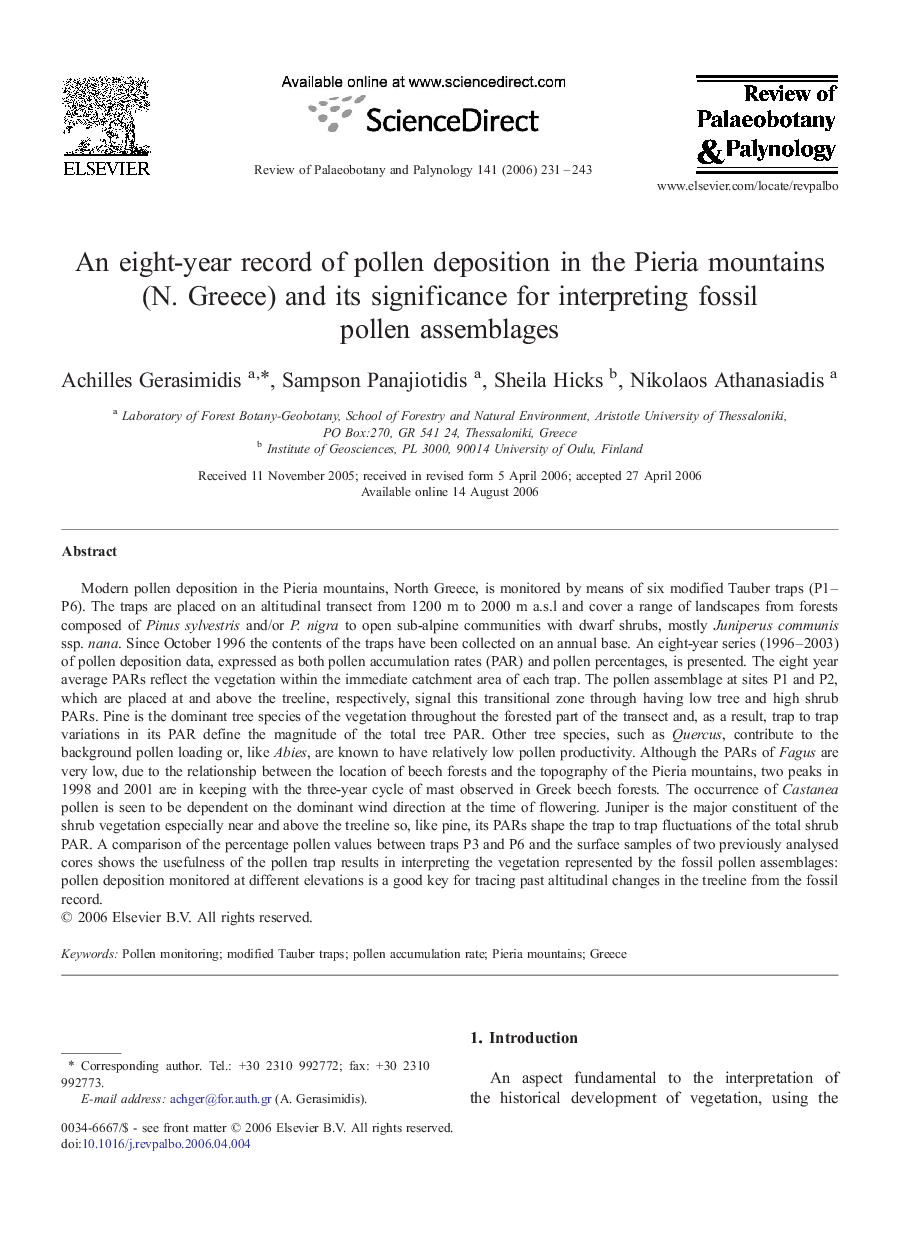| کد مقاله | کد نشریه | سال انتشار | مقاله انگلیسی | نسخه تمام متن |
|---|---|---|---|---|
| 4751231 | 1642580 | 2006 | 13 صفحه PDF | دانلود رایگان |
عنوان انگلیسی مقاله ISI
An eight-year record of pollen deposition in the Pieria mountains (N. Greece) and its significance for interpreting fossil pollen assemblages
دانلود مقاله + سفارش ترجمه
دانلود مقاله ISI انگلیسی
رایگان برای ایرانیان
موضوعات مرتبط
مهندسی و علوم پایه
علوم زمین و سیارات
فسیل شناسی
پیش نمایش صفحه اول مقاله

چکیده انگلیسی
Modern pollen deposition in the Pieria mountains, North Greece, is monitored by means of six modified Tauber traps (P1-P6). The traps are placed on an altitudinal transect from 1200Â m to 2000Â m a.s.l and cover a range of landscapes from forests composed of Pinus sylvestris and/or P. nigra to open sub-alpine communities with dwarf shrubs, mostly Juniperus communis ssp. nana. Since October 1996 the contents of the traps have been collected on an annual base. An eight-year series (1996-2003) of pollen deposition data, expressed as both pollen accumulation rates (PAR) and pollen percentages, is presented. The eight year average PARs reflect the vegetation within the immediate catchment area of each trap. The pollen assemblage at sites P1 and P2, which are placed at and above the treeline, respectively, signal this transitional zone through having low tree and high shrub PARs. Pine is the dominant tree species of the vegetation throughout the forested part of the transect and, as a result, trap to trap variations in its PAR define the magnitude of the total tree PAR. Other tree species, such as Quercus, contribute to the background pollen loading or, like Abies, are known to have relatively low pollen productivity. Although the PARs of Fagus are very low, due to the relationship between the location of beech forests and the topography of the Pieria mountains, two peaks in 1998 and 2001 are in keeping with the three-year cycle of mast observed in Greek beech forests. The occurrence of Castanea pollen is seen to be dependent on the dominant wind direction at the time of flowering. Juniper is the major constituent of the shrub vegetation especially near and above the treeline so, like pine, its PARs shape the trap to trap fluctuations of the total shrub PAR. A comparison of the percentage pollen values between traps P3 and P6 and the surface samples of two previously analysed cores shows the usefulness of the pollen trap results in interpreting the vegetation represented by the fossil pollen assemblages: pollen deposition monitored at different elevations is a good key for tracing past altitudinal changes in the treeline from the fossil record.
ناشر
Database: Elsevier - ScienceDirect (ساینس دایرکت)
Journal: Review of Palaeobotany and Palynology - Volume 141, Issues 3â4, October 2006, Pages 231-243
Journal: Review of Palaeobotany and Palynology - Volume 141, Issues 3â4, October 2006, Pages 231-243
نویسندگان
Achilles Gerasimidis, Sampson Panajiotidis, Sheila Hicks, Nikolaos Athanasiadis,